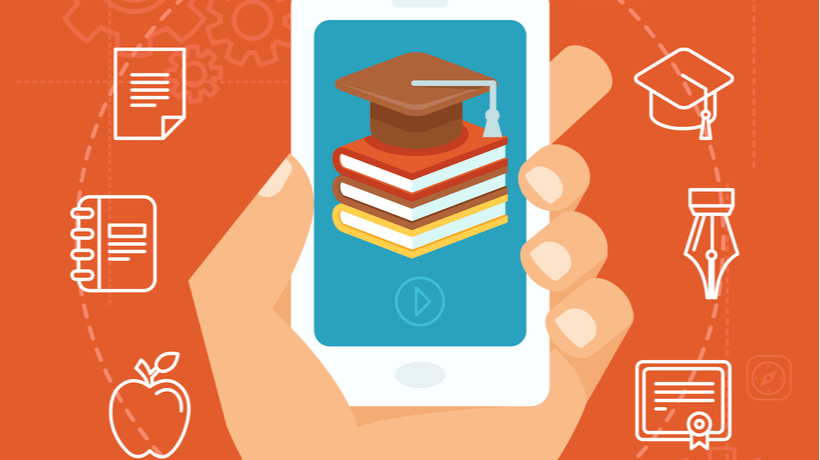Access Training Anywhere, Anytime
The evolution of technology has shifted from the classroom setting to eLearning, and now to mLearning or mobile learning. So why this shift?
Let’s look at some mobile statistics and trends:
- 86% of email users access their email accounts via mobile devices
- Consumers spend over five hours a day on their smartphones
- Around 70% of web traffic is generated by mobile devices
- 49.6% of emails opened in the US were on a smartphone
- Mobile video consumption rises by 100% every year
So, as you can see, more and more people rely on their mobile devices for their day-to-day interactions. And, if you aren’t using mLearning within your training program, you should.
Mobile-Based Training: Benefits For Companies
Here are some other advantages of mLearning for your company.
Access From Anywhere
Although desktops and, even more, laptops have made employees' lives easier, mobile phones add another layer of convenience. Employees have them on when they stop for a lunchtime sandwich, during a company meeting, and even on the road when they travel to sales meetings. Thus, training via a mobile phone is accessible anywhere and anytime. Also, shorter training sessions can even be completed in between sales calls on the road.
Empowers Employees
mLearning gives employees the freedom to train at their own pace. Because of this freedom, employees have a more positive outlook on training, which in return brings better engagement, more courses completed on time, and an increase in knowledge retention.
Brings Collaboration
Since employees are used to texting friends, sharing news articles, or forwarding an email to a family member all from their phones, mLearning offers the same level of on-the-job collaboration. If, for example, an employee has a question about a training module, they can quickly group chat with their team or instant message their manager for on-the-go help.
Helps With Retention
Bite-sized learning is breaking training up into smaller sections. This helps with retention and it is a great way to learn via mobile devices. If an employee knows how long each training session takes, they can easily log on in between other activities and build upon a new skill quickly. Plus, since the information is condensed, it’s easy to learn the key concepts and not be overwhelmed by too many details.
Increases Adaptability
If there are group training sessions for a team that spans different countries, mLearning is a better way to coordinate this learning. Instead of gathering everyone in a classroom setting, or at their desktops, employees just need their phones regardless of their location.
Saves Money
Whether you let employees use their own phones or issue company cell phones, mLearning saves money. You can use your existing content and make it mobile-friendly. This means no extra money spent on developing new training or on hiring administrators for on-site training. And, if you allow employees to use their own phones, there is no added expense for additional company-issued equipment.
How To Start Using mLearning
We should first mention that not all courses translate well to a mobile format. Employee learning is still best implemented with a blended learning platform with on-site, eLearning, and mLearning, all having a place in the training mix. With that said, there are some topics and skills that work really well for mLearning.
These include:
- Training on-demand
Training that needs to be top of mind, like sales call information or refresher courses on job site protocols. - Portable
Training that can be packaged to access on the go. In other words, the employee doesn't need to access additional materials nor use a desktop setting to facilitate the training. - Easily digestible
Quick and engaging topics, like a 15-minute training session on goal-setting tips. - Engaging
Include interesting elements like checklists, calculators, gamification in training, simulations, and videos.
Building Out Your Courses
Once you gather a list of topics that work well on a mobile platform, you’ll want to create these courses. If you think of consumer websites as different formats on your phone versus on your laptop, you need to keep the same concept in mind when developing your mLearning environment.
Ask these questions to ensure your course is mobile-friendly:
Does My Course Load Quickly?
If you have issued cell phones to company employees, everyone may have the same carrier. However, if employees are accessing the training outside the office, connectivity varies. If your employees use their own mobile devices, load times may be different among phones. Therefore, ensure that courses regarding technology can be uniformly downloaded, regardless of the environment or the device.
Can Employees Take This Course Without Help?
Next, since this is not a face-to-face class, nor a course taken on-site, can an employee walk through the course on their own? mLearning courses need to be self-explanatory regarding how to load the training module, how to progress through it, and what steps to take once the course is complete. Employees also need a way to contact the administrator if they have issues.
Is My Design Easy To Follow?
While desktops and laptops offer a fairly large screen size, mobile devices don’t. So when you are designing your course, keep this in mind. Use larger font sizes and bigger buttons. Incorporate colors that are brighter and help with course advancement. Plus, the text should be kept to a minimum, so as not to overload the learners with this smaller format.
How Can I Simplify My Concepts?
As we’ve said before, mLearning should be used for only simple sessions or to cover one main concept. The same philosophy is important when designing these courses. Have one concept per screen, so that it’s easy to see and digest the information before moving on to the next. Plus, this allows the learner to understand one idea or key point at a time.
Is My Training Session Too Long?
Since these employees will be taking training in between other tasks, they need it to be short. Aim for around 5 to 15 minutes in length. Any longer and you will lose the focus of the employees. So look at your training sessions and remove any excess or unneeded information. Just focus on high-level and important key concepts.
Creating A Corporate Mobile Learning Plan
After you’ve answered these overall questions, you’ll want to begin creating your mobile courses.
Here are a few helpful steps to take.
Define Goals
The first step is to define what goals you have for your mobile learning platform. So decide the type of training that is best suited for mobile based on the criteria we outlined. This is also a good opportunity to introduce employees to your mobile learning strategy. For example, you can survey employees asking what they would like to see in training that is not currently offered, or how you can make learning more flexible, and what problems managers are having that may be solved through additional training.
Once you have employee input and an analysis of your current training courses, you can better decide how to build your mLearning platform. And, you’ll also need to consider how employees are accessing this training. Is it on the go, like a sales team member, or remotely like a contractor? And is this through a personal cell phone or a company-issued one? Thinking through all of these logistics upfront will save you time down the road.
Set A Point Person
If you have a training department, you’ll want a person who will head up this initiative. If you have a large company, this person or team is responsible for analyzing, implementing, and revising this new mLearning initiative. Think of this individual as a project manager steering this new platform. They also need to work closely with team leaders on what training they are looking for through mobile learning and human resources if surveys were sent to employees on training improvements. Lastly, this point person needs to assign people on the team to do the work from building these courses to employees taking them in order to fine-tune the program.
Building The Learning Content
Next, you’ll want to build your content. You don’t need to start from scratch. If you did your due diligence, you’ll have a list of courses that translate well to a mobile platform. You can also use a learning management partner who can provide learning module templates to build upon.
It’s also a good idea to consider what types of learning content work best for mobile.
Here are a few examples:
What Works Well For An mLearning Curriculum?
Once your process is in place, it’s time to decide what type of content lends itself best to mLearning. You can use existing content or build short snippets using these curriculum ideas:
Assessments And Quizzes
Assessments or quizzes are a great way to keep lessons short and to the point. For example, you could offer a short quiz on new safety protocols when there is a specialist in the field. This can test their knowledge of what was learned previously. Or, if you are gauging how much an employee knows about a new product before a sales call, you can create a short quiz. Both instances provide information on the go. And based on the results, employees can quickly make adjustments on the spot to better serve their customers.
Game-Based Learning
Different from gamification in training, game-based learning, or GBL, uses a game to facilitate the learning process. GBL is a great way to get employees motivated to learn in an mLearning environment. For example, if you are developing a quick course in communication skills, there could be a game-based quiz to see if the employee could outscore the computer. Not only does this keep motivation high, but it also increases engagement and knowledge of the subject matter.
Spaced Repetition
Another curriculum concept for mLearning is spaced repetition. If you aren’t familiar with this concept, it’s repeating information over time. For example, you teach an employee about a programming language. This is an in-depth course to learn the ins and outs of using it. However, there are a few high-level points you want this employee to keep top of mind. So, you can use spaced repetition to highlight these key bits of information within your mLearning platform. This allows time to pass between the initial download of new information to actually having to recall what was learned. And when spaced repetition is used successfully, it helps new information become knowledge faster.
Media
Media, like videos, presentations, short webinars, is a great way to provide learning on the go. Employees are used to watching videos on social media or downloading the latest news podcast. So using media for mLearning is a natural fit and will keep your learners’ attention. Since you still want to keep mLearning short and to the point, these media files could be additional information to what was learned in a previous course. For example, you have an in-person class on decision-making strategies. You could then have a few example videos of good decision-making case studies available for download via your mLearning platform.
Time-Sensitive Training
As you know, there are several different types of training. mLearning can be used for time-sensitive training meaning onboarding, compliance, and product and sales training. All these types of training need to be rolled out at certain times of an employee’s time with the company. Onboarding is a great way to get employees on the road to train on an mLearning platform. Likewise, compliance, product, and new sales training also lend themselves well to just-in-time training.
mLearning Is A Powerful Employee Training Platform
With more and more consumers using their phones daily for tasks like surfing the web, making purchases, or staying in touch with friends, this same technological push should translate to your learning program. By incorporating these techniques, you can easily take your learning platform to mLearning. And your employees will have a more robust training experience that offers the increased flexibility all employees want from an employer.








